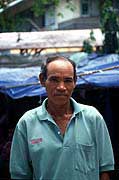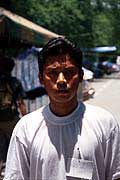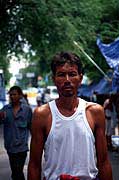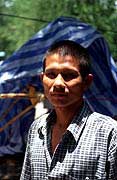VILLAGE
VIEWPOINT
Paying for progress (part two)
In the final of our two-part series, Outlook presents
the concerns of those who have lost their ancestral lands and livelihoods
and joined with the Assembly of the Poor in search of justice
Post Reporters, Aug 19, 2000
Baan Tung Lung
Story by Atiya Achakulwisut
When the Pak Moon Dam was completed in
1991, the rising water left Baan Wang Mai village an isolated island. The
stranded villagers requested that the Electricity Generating Authority of
Thailand (Egat) find new land for them, two rai for each family, and that
they receive compensation for the houses that had to be demolished. Egat
gave them some compensation for the houses, but authorities, claiming that
the villagers do not live in the flooded area, refused to find new land
for them.
In 1994, some desperate villagers began to emigrate and take over the
1,600-rai public land at the nearby Baan Tung Lung. "Baan Wang Mai
was a fish haven," Swas Laithong, 55, recalled, discussing the
good-old days in his ancestral village.
 |
|
Swas Laithong
|
"Everybody went there to fish. Normally, I was able to make 2,000
to 3,000 baht a day from my catch. When the dam came, the fish were gone.
The water became stagnant. We hardly had any fish to eat.
"For Swas, the Pak Moon Dam was a curse. It not only left his
house stranded in a man-made lake and flooded his farmlands, but also
ruined his fishing profession. "The dam has made my life miserable.
Before, I was comfortable and contented. However, I have learned how to
unite together and protest with others," the amiable father of five
said.
As yet, the villagers have not been prosecuted for trespassing on
public land. Insecurity, however, is mounting as they could be arrested at
anytime. The villagers want the public land status revoked, in which case
so they would be entitled to the land rights document. The Banharn
government resolved to survey the land.
So far, not much has been done. "I don't know how long I should
stay here (in front of Government House). It may be a long time. I hear
there are lots of fish swimming up the river now that the the dam's gates
have been opened. I wish I could go back and catch those fish like I used
to," Swas said.
Banthorn Commission's recommendations: -
Extend help for the villagers' real needs. - End all legal proceedings and
allow the villagers to stay where they are on condition that no further
encroachments are made.
- Legalise the village and set up an infrastructure for them. The
government have responded to the recommendations and have allowed the
villagers to stay where they are. The villagers are not allowed to
cultivate the land further. The government also allowed the village to
become official and to agreed to provide infrastructure. The government
has refused to stop legal proceedings.
Pong Khun Phet Dam
Story by Vasana Chinvarakorn
Last year, Sakorn Sisai received a plaque
from the government on behalf of the Lam Chiang Tha Conservation Group,
for its environmental conservation campaigns. This year, he was arrested
for joining the Assembly of the Poor in trespassing on Government House.
 |
|
Phi Morawat
|
The reason for committing the unlawful act, however, was the same
reason he was granted the award as chairman of the group. The native of
Chaiyaphum province has been protesting against the plan to build the Pong
Khun Phet Dam, which he believes will damage both the environment and the
people's way of life.
First unveiled in 1989, the Royal Irrigation Department (RID) project
is part of a master plan to regulate waterways in the upper Chi River
basin. But so far, the only results of the scheme have been a series of
scandal charges, the murder of one protester, and accusations of
manipulation by both local politicians and businessmen to pit groups of
villagers against one another.
"Those who oppose the dam have been accused of being communists,
and anti-development," Sakorn, 30, said ruefully. "State
officials have been threatening us with various violent tactics. They even
organised a few mobs in a bid to scare us away.
"But we have always abided by the law. The Constitution says local
people should have the right to manage resources. The communities (who
will be evicted if the dam is built) have been living here for
generations. People here, my wife included, belong to an ethnic group
called Chao Bon."A former director general at the RID, however,
claimed the project needed no Environmental Impact Assessment (EIA) study,
as it originated before the 1992 Environmental Act.
 |
|
Sujin Katasila
|
There have also been efforts to alter the blueprints for the dam, to
classify it as a small dam, with a storage capacity under the 100 million
cubic metres of a large-scale project that would require an EIA study.
However, a preliminary study found the RID underestimated the size of
the project, and at the same time overstated its potential benefits.
Sakorn attributes the RID's vehement objection to an impact study to
the fact that the potential losses would be too great to continue with the
programme. The Pong Khun Phet Dam, if built, will submerge five villages,
as well as one of the country's few remaining larn tree forests.
Sakorn maintained that people in his village have long earned a good
income relying on what some see as patches of dry, degraded trees. A day's
collection of bamboo shoots alone can bring in a few hundred baht. Picking
up larn leaves-a prime material for a variety of folk handicrafts-might
add a couple hundred baht more.
"Unfortunately, the group of academics who conducted the
preliminary study has not received much financial support from the
government," Sakorn lamented.
"In a public hearing, we villagers may not sound as convincing as
the state officials, who are better skilled at swaying public opinion.
That's why we need an objective study. We strongly believe that if it's
done seriously, the study will find the project entails more harm than
good."
Banthorn Commission's recommendations: -
Suspension of all dam construction.
- Allocation of funds to support the committee appointed in accordance
with the Cabinet's April 29, 1997 resolution to review four pending dam
projects.
- Setting up a public hearing to solicit the opinions of local
villagers, and releasing all relevant information as stipulated in the
1997 Information Act.
The government agreed to all recommendations. However, the Assembly of
the Poor notes that the Cabinet has been silent on the commission's
long-term recommendations for the other pending dam projects in the
region.
Hua Na Dam
Story by Ukrit Kungsawanich
Sujin Katasila is a man on a mission to
protect not only his livelihood but his entire community from yet another
government-initiated disaster before it's too late.
Today he is joining the Assembly of the Poor as they march to Bangkok,
full of hope even though the Chuan government continually turns a blind
eye to the villagers' requests.
 |
|
Sakorn Sisai
|
His hometown in Rasi Salai district, Si Sa Ket province, is the site of
the colossal Hua Na Dam, which the government officially refers to as a
"weir". With 14 doors to release the water and a solid concrete
edifice that's almost twice as big as the Pak Moon Dam, this colossus is a
long way from being a mere weir.
During the years when the stock index skyrocketed and the economy was
on the rise, the Chatchai administration launched an ambitious project to
construct 22 dams across the entire Mekong-Chi-Moon area in the Northeast
region. Hua Na Dam, part of the project under the Department of Energy
Development and Promotion, was the biggest of the lot.
"I don't understand why the government won't tell us the truth. I
heard the news that another weir will be built near our village. But a
weir, to my understanding, is a small impoundment for preventing flooding
during the monsoon season. I had no idea it would have 14 doors and that
more than 40 villages would be affected by this dam," Sujin said.
The misinformation, he says, was simply a government tactic to keep
villagers from panicking and to prevent violent opposition. But the
villagers were neither stupid nor blind, and when they saw the gigantic
weir, they knew they were in deep trouble.
"After I heard the rumour from a nearby village that the weir was
actually a dam, I went to the site to see it with my own eyes. I was
stunned by the size of it.""The head of our village was told
water from the weir would not flood our land. Even now, officers from the
department haven't told us exactly how much land will be submerged under
the water when the dam is ready to operate."Moreover, the department
hasn't yet conducted EIA studies on Hua Na Dam according to the
stipulations of the government's legislative act in 1997.
"We want the state to do an impact assessment. If the negative
impact is greater than the potential benefits of the dam, then the whole
project should be terminated and left as a monument."On July 2, 1998,
Sujin decided to organise a protest and began recruiting villagers in Rasi
Salai province. Over the next two years, he worked studiously to get the
people to speak up. Eventually, approximately 700 people joined a
demonstration in front of city hall.
But when their efforts were not acknowledged by the state, the group
joined the Assembly of the Poor to gain greater bargaining power.
"Now we have members from 34 villages and we will inundate the
government if they decide to ignore our concerns."Two of 34 villages
will suffer in particular, because they will not only lose their land but
also the substance needed for their entire livelihoods. People in Ban Co
and Ban Cone Sai are famous for their expertise in pottery-but all that
will become history if the clay near the Moon River is washed away.
"What can the government do to save these people? What will they do
when the best quality clay is no longer there?"
Banthorn Commission's recommendations: -
There must be environmental and social impact assessment studies performed
before the dam is completed.
- All the information must be made available to the public.
- The Department of Energy Development and Promotion should determine
the exact water level if the project continues.
- Release long-term plans to help the community and villagers whose
livelihoods will be shattered.
The government agreed to all the recommendations.
Kud Chompoo Forest
Story by Vasana Chinvarakorn
Were his life a ball, Phai Morawat would
have been kicked around so many times that an explosion would not be far
off.
Fifteen years ago, the military took over his family's 70-rai plot of
land. Not a single baht, Phai said, was offered to compensate the family's
loss. But then, there was still the abundant Moon River to turn to. Along
with other farmers rendered landless at the same time, Phai switched to
fishing.
Then six years ago, the completion of the Pak Moon Dam ended the poor
man's only source of income.
And yet, Phai believed that luck hadn't completely deserted him. His
in-laws offered another piece of land nearby for the young man to work.
But last year, the government declared that the entire area, where
about two hundred families were settled, would be part of the Kud Chompoo
national reserve.
"Now our back is up against the wall," said the 38-year-old
man. "The government can always wield the law to get whatever they
want. What we feel does not matter in their eyes."Phai said the
villagers had been living there for years, long before the state's
declaration giving the land national forest status.
A hundred years ago, a group of Laotian villagers, led by the governor
of Champasak Town, escaped the sweeping force of French colonisation and
sought protection in the Siamese kingdom. A new settlement sprang up near
the Moon River, aptly named as the town of Suwanwaree (Golden Water),
which is now part of Ubon Ratchathani province.
Decades later, some of the villagers decided to move upstream a little
bit, following the untimely death of two monks who had been struck by
lightning. The new village was called Ban Kham Nok Hor. Both settlements
were recognised in a government register. Moreover, some residents, Phai's
father-in-law included, possessed official land title deeds (Nor Sor 3).
Past experience has taught Phai to remain sceptical, though. He no
longer believes the law will be on the side of the villagers.
"I'm afraid that what happened to my father could be repeated with
my father-in-law, even though he has the correct documents. Since the
officers came to put up the announcement, he has been living under
stress."Down with an ulcer himself, Phai decided to fight for
justice. Since last year, villagers from the two communities have been
protesting under the banner of the Assembly of the Poor.
The Chuan cabinet agreed to review the case. According to a July 25
Resolution, those who can prove legal ownership of land will be allowed to
stay on, while a land reform document (Sor Por Kor 4-01) will be issued to
the rest. However, the latter paper will only allow villagers to work on
the land or to transfer it to their heirs, but not the right to sell it to
others.
The resolution also stipulates a verification on the boundary of the
forest, to distinguish it from residential areas and farmland.
Phai is doubtful as to how the government's latest decision will be
carried out. Many cabinet resolutions in the past have been paralysed by
provincial administrators who tend to drag their feet. Besides, the
community's right to manage natural resources continues to be ignored.
"I'm not sure of the government's mapping technique. It looks
pretty dubious to us, with forests overlapping our houses and farms.
"We don't want the meaningless Sor Por Kor paper. We may not be
well-versed in the law, but we know that we want our original rights
back."
Banthorn Commission's recommendations: -
The government should exclude community forests from residential areas and
farmland.
- The government should endorse the existing land title documents held
by the villagers.
- For the plots that have been occupied by the villagers without legal
documents, the government should accelerate the process of issuing the Sor
Por Kor 4-01 land title documents to those who qualify.
The government agreed to almost all proposals, except the sanction of
the villagers' existing documents.
|

